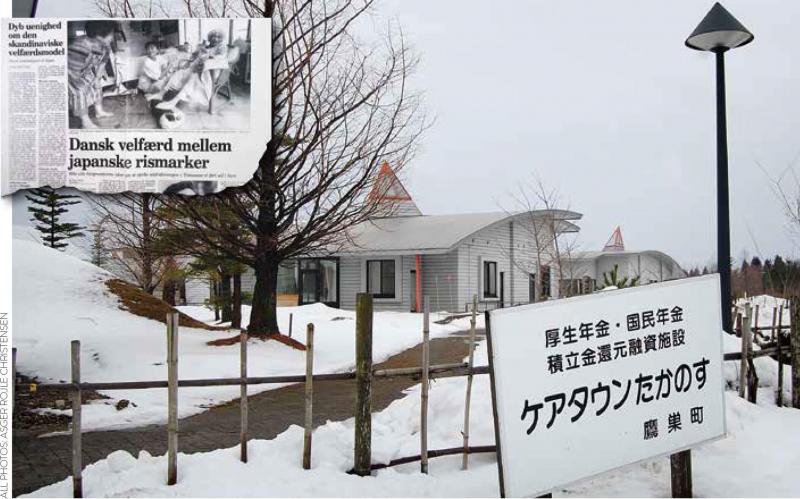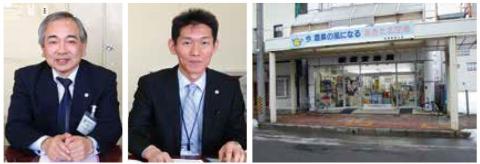Issue:

Two decades ago a fascinating social experiment began in northern Japan. Could a small town learn from Denmark’s advanced health system for the elderly?
On the nondescript outskirts of a small Akita town stands an unusually impressive structure. The stylishly curved roof and modern colors of Takanosu Care Town were designed to attract attention, for the center was to serve as a showcase for a system that would revolutionize Japanese health care. It was to display Danish design, Danish beds, Danish elderly care in fact, all the best of the Danish welfare system. It was the brainchild of the mayor of Takanosu, Tetsu Iwakawa.
I first visited the town in 1994, when Iwakawa was being seen as a visionary pioneer in Japanese elderly care. When he ran for mayor in 1991 for the first time at the age of 44, he challenged the traditional power elite of the town with promises of dramatically better care for the elderly. That helped him overthrow the incumbent mayor, who had held the post for 24 years.
As a voter I met in a café told me, “We voted for him because he was the only one who looked forward. The shops are shutting down, the young generation is leaving, the old ones are being left on their own, and everything was going downhill here in town. We did not understand his philosophy, but he gave us hope.”
Shortly after the election, Iwakawa went on a study trip to Denmark on a search for a way to keep his election promises. He was so inspired by the Danish system that over the following 11 years he led nine study trips for a total of 120 civil servants, nurses and domestic helpers from the town.
The mayor also invited a number of experts from Denmark such as the former minister for social security, Bent Rold Andersen, to give presentations on Danish welfare. He brought in expensive Danish architects, and Danish NGO’s were directly involved in the construction of the city’s elderly care facilities.
“I learned from Denmark that public welfare ought to be free for citizens,” Iwakawa told me on my visit to report on his ambitious endeavor. “If the Japanese could have more confidence in their politicians, they might not mind paying taxes so much.”
WITHIN TWO YEARS IWAKAWA dramatically increased the number of home helper employees in the municipality from five in 1991 to thirty in 1993. He converted a former clothing store on the main street into a nursing station, so that elderly citizens could drop in at the facility while shopping without feeling embarrassed.
The nurses and home caregivers didn’t simply copy what they saw in Europe, but the Danish inspiration in those years had a profound effect. One of the group leaders of the municipal home caretaker station, Yumiko Nagasaki, told me that the two countries’ understanding of elderly care is different. “In Denmark, help and assistance is seen as support for the elderly themselves, so that he or she can be more independent. In Japan, in contrast, it is basically seen as support for the family, so that the family can have more time and energy to help the elderly in everyday life.”
After being reelected in 1995, Mayor Iwakawa focused on his pet project, the Care Town elderly care center. The facility was built after much controversy, and when it opened in 1999 it was indeed something to see. As well as its contemporary architecture and design, the elderly inhabitants each had their own single room: something unique at the time. The ratio of residents to staff was not 3:1, as in the rest of Japan, but 3:2.
On top of that, a number of local regulations were introduced that differed sharply from the general practice in the rest of Japan at the time. Strict rules were put in place against restraining residents with dementia, and employees received training to handle difficult situations in other ways. Finally, residents and users had to pay a much smaller share of the costs of running the health care system than people did in other parts of the country.
Things looked good for the elderly of the little town in northern Japan. BUT, AS IS SO often true, it was financial circumstances that led to everything going south.

The many changes that Mayor Iwakawa introduced cost the town money a lot of it. What became clear, however, was that the municipality didn’t have a tax base big enough to support his big dreams. Debts began to pile up over the years, and things went from bad to worse. Other municipal buildings throughout the town schools and sports facilities became dilapidated because of the lack of funds available for maintenance.
It all led to a very abrupt end to the Danish experiment in Takanosu. After a bitter election campaign in 2003, Iwakawa failed to be elected to a fourth term as mayor. The extent of the accumulated debt was no longer a secret to the voters, and they hoped that participation in the municipal merger into Kita Akita which Iwakawa opposed would result in more taxpayers having to share the burden of the large deficit.
Meanwhile, a new law had been introduced in Japan in the year 2000. The so called long term assistance insurance system ensured a minimum of help to senior citizens in need and opened its arms to private companies. While the law actually led to significant improvements in most places in Japan, it also meant that most of the local decisions made during the Iwakawa administration that had led to better conditions for the elderly were rescinded very soon after his election defeat.
Only four years after the establishment of the Care Town Center, it was transferred from public to semiprivate status. The fees for residents and users of the Care Town Center more than doubled. The guaranteed 24hour surveillance in the home care center was abolished. The kitchen, which supplied food to the city’s elderly 24 hours a day regardless of where they lived, was closed.
CARE TOWN TAKANOSU IS no longer a showcase, I found upon my recent return to the area. It is just a semiprivate, semipublic senior center in line with other elderly care centers across Japan. Yuichi Kosaka, director of the care provider company that operates the center, says that he is “running it like a business.” The only reason that it can balance its books, he says, is that the facilities are now utilized to full capacity.
“There was never a need for such a luxurious place,” Kosaka says. “Mayor Iwakawa and the people around him just used the place as a tool to promote themselves in the eyes of the world.”
Iwakawa had received recognition for having learned in Denmark that involving working groups of citizens and experts in formulating policies was a good strategy. His supporters were very active in these working groups, while opponents argued that it was used as a way to exclude them from the decisions.
“The working groups would have been a good idea if they had made compromises and if they had cooperated more with other groups in the town,” says Yuetsu Suzuki, director of the health and welfare division of Kita Akita, the merged municipality that includes Takanosu. “Unfortunately it didn’t happen that way.”
LOCAL POLITICS CAN BE a brutal affair in Japan. With his charisma, his lofty vision and numerous initiatives, Mayor Iwakawa made many enemies in the local power elite, and in 2009 he was suddenly charged with giving illegal gifts during the 2003 election campaign.
Furious at his arrest, Iwaki refused to testify on his own behalf, and ended up spending a year in prison. He was convicted in 2012, but has appealed the judgment, and the case is ongoing. Today, he operates a pharmacy in the center of Takanosu. For several years after his defeat, he planned a comeback, but it looks increasingly unrealistic.
Also gone are the Danish beds, replaced by Japanese ones. “The truth is that we always had major problems with the Danish beds,” says director Kosaka. “They looked smart, but they broke down all the time, and it was terribly expensive to order replacement parts from Denmark or send them there to repair.”
But while the Danish system, like the beds, is no longer in place, the Danish inspiration has not entirely vanished. Not if you ask at the town hall.
Makoto Kanezawa is head of another department in the merged municipality, but he participated in one of the study trips to Denmark in the nineties and hasn’t forgotten what he learned. “Now we think of the elderly care center as a home for the residents not just as a place to go to die,” he says. “I learned that in Denmark.”
Yuetsu Suzuki, the health and welfare director and another participant in the study tours to Denmark, also finds positive remnants of the experiment. “Look at the elderly citizens of this town today,” he says. “They are mobile, they move around in society, they are enjoying their twilight years
“In the old days they never came out of their homes,” he continues. “They were ashamed of their infirmity, and their families didn’t have the energy to help them get around. There has been a huge change, and it is a result of what occured during the Danish period.”
Asger Rojle Christensen was Tokyo correspondent for various Danish news media from 1989 until 1995. He is back in Japan as a journalist/ analyst reporting on Asia. (A longer version of this article was first published in February 2014 in Danish).

